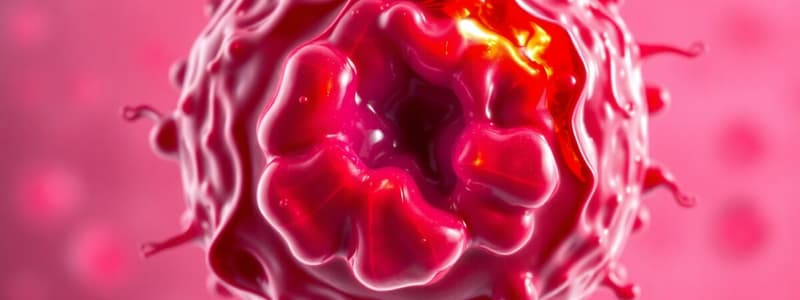Podcast
Questions and Answers
What happens to ATP production when oxygen levels are low?
What happens to ATP production when oxygen levels are low?
- ATP production decreases due to insufficient oxidative phosphorylation. (correct)
- ATP production increases anaerobically without using glycogen.
- ATP production remains the same regardless of oxygen levels.
- ATP production shifts entirely to aerobic pathways.
Which of the following is considered a downstream effect of reduced ATP supply in cells?
Which of the following is considered a downstream effect of reduced ATP supply in cells?
- Elevated ion imbalances. (correct)
- Enhanced oxidative phosphorylation.
- Increased protein synthesis.
- Stabilized membrane integrity.
What is hypertrophy in the context of cellular responses to stress?
What is hypertrophy in the context of cellular responses to stress?
- Increase in cell size. (correct)
- Formation of new cells.
- Decrease in cell size.
- Loss of cell function.
What key consequence arises from membrane damage due to cellular injury?
What key consequence arises from membrane damage due to cellular injury?
Which process primarily compensates for low oxygen levels in cells?
Which process primarily compensates for low oxygen levels in cells?
What is a characteristic feature of irreversible cellular injury?
What is a characteristic feature of irreversible cellular injury?
How does reduced ATP availability affect the sodium-potassium pump?
How does reduced ATP availability affect the sodium-potassium pump?
What role do extracellular matrix components play in cellular injury and stress responses?
What role do extracellular matrix components play in cellular injury and stress responses?
What is one cause of cellular injury mentioned in the content?
What is one cause of cellular injury mentioned in the content?
Which mechanism can lead to protein misfolding or DNA damage?
Which mechanism can lead to protein misfolding or DNA damage?
What occurs as a result of damaged plasma membranes?
What occurs as a result of damaged plasma membranes?
Which of the following is NOT a type of cellular injury mechanism described?
Which of the following is NOT a type of cellular injury mechanism described?
What is an example of an injurious stimulus that may lead to cancer?
What is an example of an injurious stimulus that may lead to cancer?
In the context of cellular injury, which scenario exemplifies reversible injury?
In the context of cellular injury, which scenario exemplifies reversible injury?
How does cellular response to injury typically occur?
How does cellular response to injury typically occur?
What role does the plasma membrane fulfill in cellular function?
What role does the plasma membrane fulfill in cellular function?
What can mitochondrial damage lead to in a cell?
What can mitochondrial damage lead to in a cell?
What does ischemia indicate in a tissue context?
What does ischemia indicate in a tissue context?
How can excess calcium entry lead to cellular damage?
How can excess calcium entry lead to cellular damage?
Which of the following correctly describes a consequence of mitochondrial dysfunction?
Which of the following correctly describes a consequence of mitochondrial dysfunction?
Which cellular injury mechanism is caused by impaired blood flow?
Which cellular injury mechanism is caused by impaired blood flow?
What is a potential outcome when the cell membrane is compromised?
What is a potential outcome when the cell membrane is compromised?
What does the term 'ion channels' refer to in the context of cellular injury?
What does the term 'ion channels' refer to in the context of cellular injury?
Which process might occur if cellular injury is reversible?
Which process might occur if cellular injury is reversible?
Flashcards are hidden until you start studying
Study Notes
Cellular Injury Mechanisms
- Cell membrane damage: Disrupts regulating what enters and exits the cell, leading to leaking of cellular components and potential digestion of intracellular components.
- Examples: Weight training, physical trauma.
- Protein misfolding or DNA damage: Can be caused by exposure to radiation or carcinogens.
- Examples: UV radiation, chemicals.
- Mitochondrial damage: Can lead to cell membrane damage, protein misfolding, and DNA damage.
- Calcium entry into the cell: Can occur due to cell membrane dysfunction, ion channel changes, or diffusion gradient imbalances.
- Impacts mitochondrial permeability and activates enzymes.
- Ischemia: Insufficient oxygen delivery to tissue:
- Examples: Heart attack (cardiac muscle), stroke (brain tissue).
- Leads to mitochondrial dysfunction, reduced ATP production, sodium-potassium pump malfunction, and impaired protein synthesis.
- Can result in membrane damage.
Cell Response to Stress
- Hypertrophy: Increase in cell size without an increase in cell number.
- Example: Weight training.
Studying That Suits You
Use AI to generate personalized quizzes and flashcards to suit your learning preferences.




